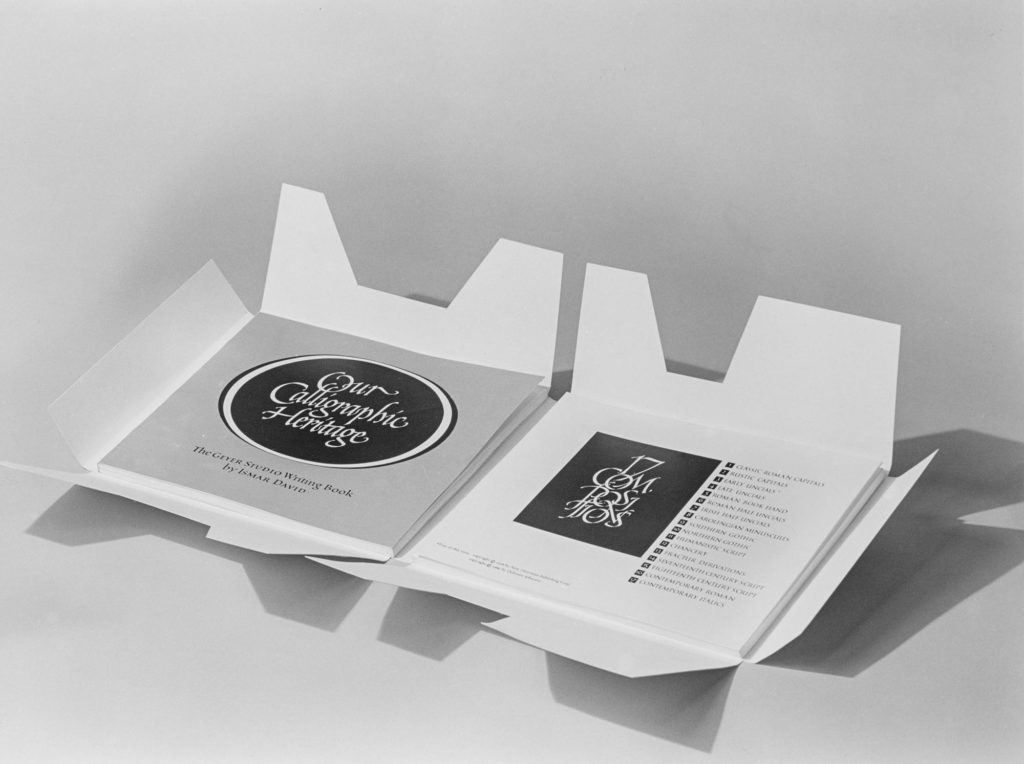Paul Standard’s review of Our Calligraphic Heritage appeared in Fine Print, volume VI, number 2, April 1980.
David, Ismar. Our Calligraphic Heritage. The Geyer Studio Writing Book.
New York: The Geyer Studio, [1979].
Oblong 8vo. 38pp., plus thirty-four 4-page folders,
all enclosed in a cloth-covered wooden easel-case.
Signed by the author/calligrapher.
$67.50 plus $3.50 shipping from Geyer Studio,
P.O. Box 1311, New York, New York, 10008.
We need hardly say that our calligraphic heritage was not invented by Ismar David. But it is perfectly true to say the Our Calligraphic Heritage is a book which present that tangled heritage in terms and figures of uniquely graceful clarity, to enrich the taste of every living practitioner of letterforms, and to give (perhaps for the first time) a full view of a landscape of letters to a world readership.
It is a heritage of enormous scope, hitherto lying scattered in many hundreds of scholarly volumes available to specialists, but now taken in hand by a scholar-artist who is also an artist-scholar. Undaunted by the complexities of the task, Ismar David has discerned the threads of related families of letters, and has presented them in a text supported by graphic illustration, enlightening to the reader and inspiring to the practitioner. Seventeen styles are presented, beginning with Classic Roman Capitals, and continuing through various uncials, Carolingian Minuscules, Gothic, Humanistic, Chancery, Fraktur, etc., and ending with contemporary italics.
To produce such a work, the very boundaries of the book-making art had to be extended, as its title page declares: “The Geyer Studio Writing Book — Text, Charts, and Compositions by Ismar David.” It therefore consists of three major units: first, a paperbound writing book containing a narrative text with clarifying charts and figures for each style; second a set of seventeen folders to display the major historic styles, with printed remarks and graphic detail as needed; and third, a series of seventeen folders, each with a different multi-color calligraphic composition by Ismar David, to show how each classical form can be adapted into motifs for current use in the graphic arts. All three components are brightly distinctive in their use of color. This trinity of parts is housed in a wood-frame box with a heavy buckram cover. This latter feature turns it into something new in bookmaking because it is so ingeniously hinged as to become a lectern whereon a single folder or series may be placed, its bottom edge resting on a ledge to keep the chart vertical, while the reader is free to flank the lectern at left and right with other folders needed for instant comparison. This device makes detailed study of the forms a straightaway instead of an entangling process. And since the reader can easily bring forward the two or several folders needed to decide some point of difference or similarity, he will have more comfort in this than the usual textbook.
I have spoken at length of this bookmaking breakthrough because of its novelty. But I must add that every page of text and every style of letter shown is made with such exemplary finesse and accuracy as could only be lavished by an author solidly informed and long in love with all letters and with worth bookmaking.



























